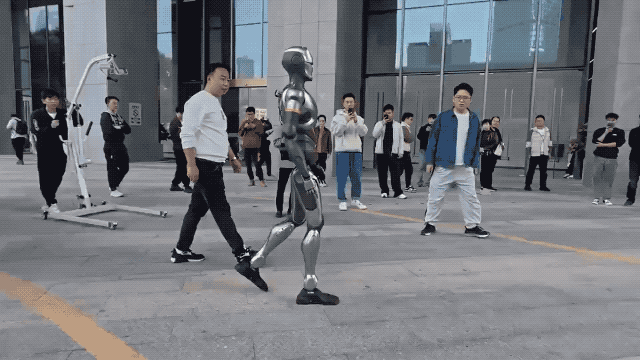发布时间:
来源: GD TODAY

Artificial intelligence (AI) robots are gaining traction in Shenzhen, South China's Guangdong Province, with a humanoid robot in Nanshan district now serving as a grid-based community worker and police officer. Powered by DeepSeek's advanced large language models, the AI technology is being utilized in Futian district to enhance administrative governance and improve public services.
A video released Monday by the Guangdong Radio and Television's Chudian new media platform showcases a 1.38-meter-tall humanoid robot in a grid-based community worker's uniform assisting with patrols and inspecting streets, while another robot takes on the role of police officer, shaking hands with officers and waving to the crowd.
The robots are developed by Shenzhen EngineAI Robotics Technology Co. A company representative told the Global Times on Monday that the robots featured in the video are one of three humanoid models launched by the company. The latest version, PM01, comes equipped with optimized algorithms for improved stability and real-world performance.
During the Spring Festival holidays, the humanoid robots, equipped with police gear, accompanied officers on patrol in the streets, according to the Shenzhen government website.
The PM01 is 1.38 centimeters tall, weighs about 40 kilograms, and features 24 degrees of freedom (DoF), achieving a movement speed of two meters a second. It is equipped with a 320-degree rotational motor at the waist, allowing it to perform a wide range of complex movements. The robot features two walking modes: a mechanical gait and a natural humanoid gait, the company representative told the Global Times.
This is not the first time that robots have been used for grassroots governance. Previously, a humanoid robot standing 170 centimeters tall, walking with agile and fluid steps on the streets of Shenzhen, went viral. According to a video posted by the official account of the Nanshan District Government, this robot, SE01, was also developed by the same company.
According to EngineAI Robotics Technology, SE01 can perform human-like actions such as squatting, push-ups, spinning, grabbing and running. For the first time globally, it has successfully overcome the challenge of achieving a natural, human-like walking motion. This breakthrough eliminates the awkward small steps, bent legs and stomping movements common in other robots, enabling a smoother, faster, more stable and graceful gait — bringing robots one step closer to human-like mobility.
Many netizens exclaimed, "The robot's walking motion is so natural and realistic!" Others pointed out that as grid workers face the public and handle complex tasks, it's truly great that robots can be used in community grid management.
Robots can alleviate human resource burden in grassroots governance. As is widely known, traditional grassroots governance often requires significant manpower. The introduction of AI and robots can partially replace human labor, Wang Peng, an associate research fellow at the Beijing Academy of Social Sciences, told the Global Times on Monday.
"This allows grassroots personnel to focus more on tasks requiring human intelligence and emotional engagement, such as community care and conflict resolution," Wang added.
The 70 DeepSeek-powered "AI public servants" employed in Shenzhen's Futian district are another example of intelligent grassroots governance, ensuring document format corrections with an accuracy rate of over 95 percent, according to a statement released by the district on Saturday.
The AI employees were built on the full-size DeepSeek R1 model. The 70 digital employees were deployed in 11 functional areas, enhancing efficiency across the government service ecosystem, including document processing, public service, emergency management, as well as business development and investment promotion.
The AI system has reduced the time needed for personalized content generation from five days to just a few minutes. The accuracy of document format corrections exceeds 95 percent, cutting audit times by 90 percent, and the error rate remains below 5 percent.
According to the article, with the assistance of these digital employees, the accuracy in processing public service requests has increased from 70 percent to 95 percent. The safety compliance AI assistant has enhanced rehearsal script generation efficiency by 100 times. The AI investment attraction assistant has streamlined corporate analysis and screening, increasing efficiency by 30 percent. The AI task supervision assistant has boosted cross-departmental task delegation efficiency by 80 percent, and the on-time completion rate has increased by 25 percent.
"Digital employees can significantly improve the efficiency and precision of grassroots governance. They can work around the clock without physiological limitations, responding swiftly to various emergencies," Wang said.
Xiang Ligang, a telecom expert, pointed out that this does not imply AI services will be devoid of human warmth. "When presented with the same facts, these models generate responses that are both engaging and contextually appropriate, enhancing the user experience. This is a valuable aspect," he added.
